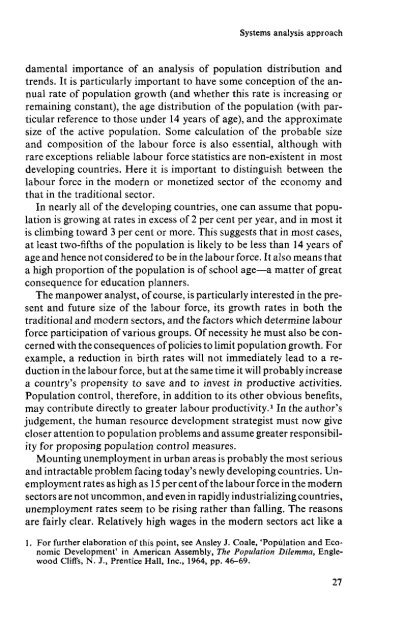Educational planning and human resource ... - unesdoc - Unesco
Educational planning and human resource ... - unesdoc - Unesco
Educational planning and human resource ... - unesdoc - Unesco
You also want an ePaper? Increase the reach of your titles
YUMPU automatically turns print PDFs into web optimized ePapers that Google loves.
Systems analysis approach<br />
damental importance of an analysis of population distribution <strong>and</strong><br />
trends. It is particularly important to have some conception of the an-<br />
nual rate of population growth (<strong>and</strong> whether this rate is increasing or<br />
remaining constant), the age distribution of the population (with par-<br />
ticular reference to those under 14 years of age), <strong>and</strong> the approximate<br />
size of the active population. Some calculation of the probable size<br />
<strong>and</strong> composition of the labour force is also essential, although with<br />
rare exceptions reliable labour force statistics are non-existent in most<br />
developing countries. Here it is important to distinguish between the<br />
labour force in the modern or monetized sector of the economy <strong>and</strong><br />
that in the traditional sector.<br />
In nearly all of the developing countries, one can assume that popu-<br />
lation is growing at rates in excess of 2 per cent per year, <strong>and</strong> in most it<br />
is climbing toward 3 per cent or more. This suggests that in most cases,<br />
at least two-fifths of the population is likely to be less than 14 years of<br />
age <strong>and</strong> hence not considered to be in the labour force. It also means that<br />
a high proportion of the population is of school age-a matter of great<br />
consequence for education planners.<br />
The manpower analyst, of course, is particularly interested in the pre-<br />
sent <strong>and</strong> future size of the labour force, its growth rates in both the<br />
traditional <strong>and</strong> modern sectors, <strong>and</strong> the factors which determine labour<br />
force participation of various groups. Of necessity he must also be con-<br />
cerned with the consequences of policies to limit population growth. For<br />
example, a reduction in birth rates wil not immediately lead to a re-<br />
duction in the labour force, but at the same time it will probably increase<br />
a country’s propensity to save <strong>and</strong> to invest in productive activities.<br />
Population control, therefore, in addition to its other obvious benefits,<br />
may contribute directly to greater labour pr0ductivity.l In the author’s<br />
judgement, the <strong>human</strong> <strong>resource</strong> development strategist must now give<br />
closer attention to population problems <strong>and</strong> assume greater responsibil-<br />
ity for proposing population control measures.<br />
Mounting unemployment in urban areas is probably the most serious<br />
<strong>and</strong> intractable problem facing today’s newly developing countries. Un-<br />
employment rates as high as 15 per cent of the labour force in the modern<br />
sectors are not uncommon, <strong>and</strong> even in rapidly industrializing countries,<br />
unemployment rates seem to be rising rather than falling. The reasons<br />
are fairly clear. Relatively high wages in the modern sectors act like a<br />
1. For further elaboration of this point, see Ansley J. Coale, ‘Population <strong>and</strong> Eco-<br />
nomic Development’ in American Assembly, The Popularion Dilemma, Engle-<br />
wood Cliffs, N. J., Prentice Hall, Inc., 1964, pp. 46-69.<br />
27

















